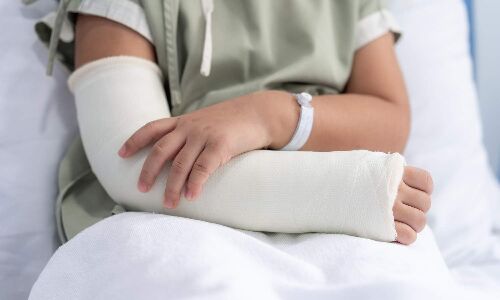
A randomized clinical trial involving more than 1,600 patients with open fractures found that two antiseptic solutions routinely used by surgeons prior to fracture surgery are equally effective for preventing post-surgical infections. Based on the results of this trial, the study leaders from the University of Maryland School of Medicine (UMSOM) and McMaster University concluded that orthopedic surgeons could select either of the two solutions-aqueous 10% povidone-iodine or aqueous 4% chlorhexidine gluconate-for infection prevention.
The study, called Aqueous-PREP, was published in The Lancet and presented yesterday at the Orthopaedic Trauma Association meeting in Tampa, FL. Study participants were enrolled from a total of 14 hospitals, including the University of Maryland Medical Center (UMMC), as well as other facilities in the U.S., Canada, and Spain.
“Many surgeons prefer to use povidone-iodine skin preparation for open fractures because of its wide availability as an effective aqueous solution,” said study co-principal investigator Gerard Slobogean, MD, MPH, Associate Professor of Orthopedics at UMSOM and an orthopedic trauma surgeon at the R Adams Cowley Shock Trauma Center at UMMC. “Our findings should reassure surgeons that either antiseptic solution is fine to use, and they can base their decision on product availability, cost, or patient contraindications,” Dr. Slobogean added.
To conduct the trial, the researchers recruited patients with open fractures that required surgery at the 14 participating hospitals. Each hospital was randomly assigned to use one of the antiseptic formulations at the beginning of the three-year trial; then, each hospital alternated between the solutions every two months.
This unique study design, known as a multiple period cluster randomized crossover trial, ensured that all the hospitals used both formulations equally and controlled for variations among hospitals that could have also affected post-surgical infection rates.
“Open fractures are often devastating injuries that can be challenging to study due to the severity of the injuries and their need for urgent surgery. Patient engagement and our novel study design were key to overcoming many of the logistical challenges,” said Sheila Sprague, PhD, MSc, co-principal investigator of the trial and an Associate Professor and Research Director at McMaster University.
Jeff Wells, trial executive committee member and patient partner, agrees. “As a patient involved in the trial, it was my job to ensure that the voice of trauma patients was heard in the design, implementation, and dissemination of the trial. However, many months into the project, I learned that involving patients in study leadership was uncommon,” Wells said.
Added Andrew Pollak, MD, the James Lawrence Kernan Professor and Chair of the Department of Orthopedics at UMSOM and Senior Vice President and Chief Clinical Officer for the 11-hospital University of Maryland Medical System (UMMS), “This is a landmark study with important clinical implications. The findings are not only relevant to the management of open fractures but might also apply to the surgical treatment of other traumatic wounds.”
Aqueous-PREP is one of two trials being led by Dr. Slobogean and colleagues that are aimed at closing gaps in the medical literature on the most effective infection-control techniques in orthopedic surgery.
The study designs follow a master protocol called PREP-IT (Program of Randomized Trials to Evaluate Pre-operative Antiseptic Skin Solutions in Orthopaedic Trauma) to test infection prevention techniques in trials that will provide crucial evidence to help guide surgical practices. The second study called PREPARE will evaluate the use of two alcohol-based antiseptic skin preparations in surgical patients with both open and closed lower extremity fractures.
“Extremity fractures and the challenging surgical site infections that result from them pose a significant healthcare burden on our nation,” said Mark T. Gladwin, MD, Vice President for Medical Affairs, University of Maryland, Baltimore, and the John Z. and Akiko K. Bowers Distinguished Professor and Dean, University of Maryland School of Medicine. “The master protocol used in this study provides efficiencies in study design and data collection and could serve as an important model for future comparative effectiveness studies in the surgical field.”
This research was supported by the PREP-IT Investigators, which includes a network of over 200 physicians, allied health care providers, trauma patients, and clinical researchers. This trial was funded by the US Department of Defense (W81XWH-17-1-070), the Canadian Institutes of Health Research (Foundation Grant), McMaster University Surgical Associates, and the PSI Foundation.
References:
1. Kortram K Bezstarosti H Metsemakers W-J Raschke MJ Van Lieshout EMM Verhofstad MHJ Risk factors for infectious complications after open fractures; a systematic review and meta-analysis. Int Orthop. 2017; 41: 1965-1982
2. Tornetta P Della Rocca GJ Morshed S et al. Risk factors associated with infection in open fractures of the upper and lower extremities. J Am Acad Orthop Surg Glob Res Rev. 2020; 4e20.00188
3. Berner JE Chan JKK Gardiner MD et al. International Lower Limb Collaborative (INTELLECT) study: a multicentre, international retrospective audit of lower extremity open fractures. Br J Surg. 2022; 109: 792-795
4. Major Extremity Trauma Research Consortium Modern external ring fixation versus internal fixation for treatment of severe open tibial fractures: a randomized clinical trial (FIXIT Study). J Bone Joint Surg Am. 2022; 104: 1061-1067
